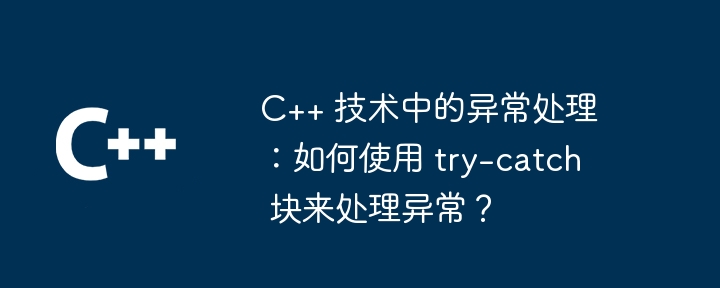
The try-catch block in C is used to handle abnormal events beyond the program's expectations to prevent program errors or crashes. The syntax is: try {...} catch (const exception& e) {...}, where the try block is the code that may throw an exception, and the catch block is the code that handles the exception. Usage tips: Try to use try-catch in functions for exception handling; use specific exception classes to indicate exception types; avoid using empty statements in catch blocks; you can use multiple clauses in catch blocks to handle different exceptions; you can use std:: rethrow() rethrows an exception; using the noexcept keyword to declare a function will not throw an exception.

Exception handling in C technology: using try-catch blocks to handle exceptions
Exception is a kind of exception that occurs beyond the expectations of the program events that may cause program errors or crashes. C provides an exception handling mechanism to handle these exceptions.
try-catch block
The try-catch block is a control structure used to handle exceptions. Its syntax is as follows:
try { // 可能会抛出异常的代码 } catch (const exception& e) { // 处理异常的代码 }
Practical case
The following is a code example that uses a try-catch block to handle file opening exceptions:
#include#include using namespace std; int main() { ifstream file; try { file.open("test.txt"); if (!file.is_open()) throw runtime_error("文件打开失败"); // 文件处理代码 file.close(); } catch (const exception& e) { cout << "异常消息:" << e.what() << endl; } return 0; }
In In the code, we first try to open the file. If the file fails to open, it will throw aruntime_errorexception. We catch the exception in a catch block and print the exception message.
Use tips
std::rethrow()to rethrow an exception.noexceptkeyword to declare that a function will not throw an exception at compile time.The above is the detailed content of Exception handling in C++ technology: How to use try-catch blocks to handle exceptions?. For more information, please follow other related articles on the PHP Chinese website!
 What are the differences between c++ and c language
What are the differences between c++ and c language Recommended learning order for c++ and python
Recommended learning order for c++ and python Cost-effectiveness analysis of learning python and c++
Cost-effectiveness analysis of learning python and c++ Is c language the same as c++?
Is c language the same as c++? Which is better to learn first, c language or c++?
Which is better to learn first, c language or c++? The difference and connection between c language and c++
The difference and connection between c language and c++ C++ software Chinese change tutorial
C++ software Chinese change tutorial Cost-effectiveness analysis of learning python, java and c++
Cost-effectiveness analysis of learning python, java and c++



